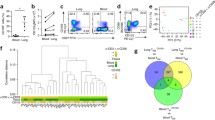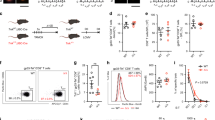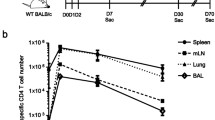Abstract
A majority of T cells from chronic inflammatory tissues derived from patients with nasal polyposis were found to express an effector memory phenotype. We report here that these memory T cells failed to activate NF-κB in response to TCR stimulation but responded normally when the proximal TCR signaling molecules were bypassed with PMA and ionomycin. The dysfunction of these cells was associated with a decrease in the phosphorylation of several TCR proximal signaling molecules including ZAP70, Lck and SLP-76. In addition to the disruption in the TCR signaling pathway, the nasal polyp-associated T cells were shown to have a defect in their ability to translocate LAMP-1 to the cell surface. The results presented here establish that the phenotype and anergy of the T cells in the nasal polyp are similar to those which is seen in memory T cells derived from human tumors and other sites of chronic inflammation.








Similar content being viewed by others
References
Agnellini P, Wolint P, Rehr M, Cahenzli U, Karrer U, Oxenius A (2007) Impaired NFAT nuclear translocation results in split exhaustion of virus-specific CD8+ T cell functions during chronic viral infection. Proc Natl Acad Sci USA 104:4564–4570
Agrawal S, Marquet J, Delfau-Larue MH, Copie-Bergman C, Jouault H, Reyes F, Bensussan A, Farcet JP (1998) CD3 hyporesponsiveness and in vitro apoptosis are features of T cells from both malignant and nonmalignant secondary lymphoid organs. J Clin Invest 102:1715–1723
Ahmed R, Gray D (1996) Immunological memory and protective immunity: understanding their relation. Science 272:54–60
Barber DL, Wherry EJ, Masopust D, Zhu B, Allison JP, Sharpe AH, Freeman GJ, Ahmed R (2006) Restoring function in exhausted CD8 T cells during chronic viral infection. Nature 439:682–687
Bernstein JM, Ballow M, Rich G, Allen C, Swanson M, Dmochowski J (2004) Lymphocyte subpopulations and cytokines in nasal polyps: is there a local immune system in the nasal polyp? Otolaryngol Head Neck Surg 130:526–535
Betts MR, Brenchley JM, Price DA, De Rosa SC, Douek DC, Roederer M, Koup RA (2003) Sensitive and viable identification of antigen-specific CD8+ T cells by a flow cytometric assay for degranulation. J Immunol Methods 281:65–78
Blackburn SD, Shin H, Haining WN, Zou T, Workman CJ, Polley A, Betts MR, Freeman GJ, Vignali DA, Wherry EJ (2009) Coregulation of CD8+ T cell exhaustion by multiple inhibitory receptors during chronic viral infection. Nat Immunol 10:29–37
Broderick L, Bankert RB (2006) Membrane-associated TGF-beta1 inhibits human memory T cell signaling in malignant and nonmalignant inflammatory microenvironments. J Immunol 177:3082–3088
Broderick L, Brooks SP, Takita H, Baer AN, Bernstein JM, Bankert RB (2006) IL-12 reverses anergy to T cell receptor triggering in human lung tumor-associated memory T cells. Clin Immunol 118:159–169
Broderick L, Yokota SJ, Reineke J, Mathiowitz E, Stewart CC, Barcos M, Kelleher RJ Jr, Bankert RB (2005) Human CD4+ effector memory T cells persisting in the microenvironment of lung cancer xenografts are activated by local delivery of IL-12 to proliferate, produce IFN-gamma, and eradicate tumor cells. J Immunol 174:898–906
Chiodetti L, Choi S, Barber DL, Schwartz RH (2006) Adaptive tolerance and clonal anergy are distinct biochemical states. J Immunol 176:2279–2291
Dagur PK, Sharma B, Kumar G, Khan NA, Katoch VM, Sengupta U, Joshi B (2010) Mycobacterial antigen(s) induce anergy by altering TCR- and TCR/CD28-induced signalling events: insights into T-cell unresponsiveness in leprosy. Mol Immunol 47:943–952
Feunou P, Poulin L, Habran C, Le Moine A, Goldman M, Braun MY (2003) CD4 + CD25+ and CD4 + CD25− T cells act respectively as inducer and effector T suppressor cells in superantigen-induced tolerance. J Immunol 171:3475–3484
George TC, Basiji DA, Hall BE, Lynch DH, Ortyn WE, Perry DJ, Seo MJ, Zimmerman CA, Morrissey PJ (2004) Distinguishing modes of cell death using the ImageStream multispectral imaging flow cytometer. Cytometry A 59:237–245
George TC, Fanning SL, Fitzgerald-Bocarsly P, Medeiros RB, Highfill S, Shimizu Y, Hall BE, Frost K, Basiji D, Ortyn WE et al (2006) Quantitative measurement of nuclear translocation events using similarity analysis of multispectral cellular images obtained in flow. J Immunol Methods 311:117–129
Gray-Owen SD, Blumberg RS (2006) CEACAM1: contact-dependent control of immunity. Nat Rev Immunol 6:433–446
Hu HL, Cornwell WD, Rogers TJ, Lin YS (1996) In vivo analysis of a superantigen-induced T cell suppressor factor. Cell Immunol 167:285–292
Jarnicki AG, Fitzpatrick DR, Robinson BW, Bielefeldt-Ohmann H (1996) Altered CD3 chain and cytokine gene expression in tumor infiltrating T lymphocytes during the development of mesothelioma. Cancer Lett 103:1–9
Jelley-Gibbs DM, Dibble JP, Filipson S, Haynes L, Kemp RA, Swain SL (2005) Repeated stimulation of CD4 effector T cells can limit their protective function. J Exp Med 201:1101–1112
Letvin NL, Walker BD (2003) Immunopathogenesis and immunotherapy in AIDS virus infections. Nat Med 9:861–866
Li H, Pauza DC (2011) Interplay of T-cell receptor and interleukin-2 signalling in Vγ2Vδ2 T-cell cytotoxicity. Immunology 132:96–103
Luxenberger W, Posch U, Berghold A, Hofmann T, Lang-Loidolt D (2000) HLA patterns in patients with nasal polyposis. Eur Arch Otorhinolaryngol 257:137–139
Maccalli C, Pisarra P, Vegetti C, Sensi M, Parmiani G, Anichini A (1999) Differential loss of T cell signaling molecules in metastatic melanoma patients' T lymphocyte subsets expressing distinct TCR variable regions. J Immunol 163:6912–6923
Macian F, Garcia-Cozar F, Im SH, Horton HF, Byrne MC, Rao A (2002) Transcriptional mechanisms underlying lymphocyte tolerance. Cell 109:719–731
Markel G, Seidman R, Stern N, Cohen-Sinai T, Izhaki O, Katz G, Besser M, Treves AJ, Blumberg RS, Loewenthal R et al (2006) Inhibition of human tumor-infiltrating lymphocyte effector functions by the homophilic carcinoembryonic cell adhesion molecule 1 interactions. J Immunol 177:6062–6071
Martens PB, Goronzy JJ, Schaid D, Weyand CM (1997) Expansion of unusual CD4+ T cells in severe rheumatoid arthritis. Arthritis Rheum 40:1106–1114
Medeiros RB, Burbach BJ, Mueller KL, Srivastava R, Moon JJ, Highfill S, Peterson EJ, Shimizu Y (2007) Regulation of NF-kappaB activation in T cells via association of the adapter proteins ADAP and CARMA1. Science 316:754–758
Migueles SA, Osborne CM, Royce C, Compton AA, Joshi RP, Weeks KA, Rood JE, Berkley AM, Sacha JB, Cogliano-Shutta NA et al (2008) Lytic granule loading of CD8+ T cells is required for HIV-infected cell elimination associated with immune control. Immunity 29:1009–1021
Molnar-Gabor E, Endreffy E, Rozsasi A (2000) HLA-DRB1, -DQA1, and -DQB1 genotypes in patients with nasal polyposis. Laryngoscope 110:422–425
Moosig F, Csernok E, Wang G, Gross WL (1998) Costimulatory molecules in Wegener's granulomatosis (WG): lack of expression of CD28 and preferential up-regulation of its ligands B7-1 (CD80) and B7-2 (CD86) on T cells. Clin Exp Immunol 114:113–118
Mueller SN, Ahmed R (2009) High antigen levels are the cause of T cell exhaustion during chronic viral infection. Proc Natl Acad Sci USA 106:8623–8628
Nel AE, Slaughter N (2002) T-cell activation through the antigen receptor. Part 2: role of signaling cascades in T-cell differentiation, anergy, immune senescence, and development of immunotherapy. J Allergy Clin Immunol 109:901–915
Peggs KS, Quezada SA, Allison JP (2008) Cell intrinsic mechanisms of T-cell inhibition and application to cancer therapy. Immunol Rev 224:141–165
Ramírez-Anguiano J, Yamamoto-Furusho JK, Barquera R, Beltrán O, Granados J (2006) Association of HLA-DR3 and HLA-DR4 with sinonasal polyposis in Mexican Mestizos. Otolaryngol Head Neck Surg 135:90–93
Sanchez-Segura A, Brieva JA, Rodriguez C (1998) T lymphocytes that infiltrate nasal polyps have a specialized phenotype and produce a mixed TH1/TH2 pattern of cytokines. J Allergy Clin Immunol 102:953–960
Schirmer M, Goldberger C, Wurzner R, Duftner C, Pfeiffer KP, Clausen J, Neumayr G, Falkenbach A (2002) Circulating cytotoxic CD8(+) CD28(−) T cells in ankylosing spondylitis. Arthritis Res 4:71–76
Schooley K, Zhu P, Dower SK, Qwarnstrom EE (2003) Regulation of nuclear translocation of nuclear factor-kappaB relA: evidence for complex dynamics at the single-cell level. Biochem J 369:331–339
Simpson-Abelson MR, Purohit VS, Pang WM, Iyer V, Odunsi K, Demmy TL, Yokota SJ, Loyall JL, Kelleher RJ Jr, Balu-Iyer S, Bankert RB (2009) IL-12 delivered intratumorally by multilamellar liposomes reactivates memory T cells in human tumor microenvironments. Clin Immunol 132:71–82
Sloan-Lancaster J, Shaw AS, Rothbard J, Allen PM (1994) Partial T cell signaling: altered phospho-zeta and lack of zap70 recruitment in APL-induced T cell anergy. Cell 79:913–922
Sommer J (1977) To cationize glass. J Cell Biol 75:745a
Sundstedt A, Sigvardsson M, Leanderson T, Hedlund G, Kalland T, Dohlsten M (1996) In vivo anergized CD4+ T cells express perturbed AP-1 and NF-kappa B transcription factors. Proc Natl Acad Sci USA 93:979–984
Vallejo AN, Weyand CM, Goronzy JJ (2004) T-cell senescence: a culprit of immune abnormalities in chronic inflammation and persistent infection. Trends Mol Med 10:119–124
Wong RM, Scotland RR, Lau RL, Wang C, Korman AJ, Kast WM, Weber JS (2007) Programmed death-1 blockade enhances expansion and functional capacity of human melanoma antigen-specific CTLs. Intl Immunol 19:1223–1234
Zha Y, Marks R, Ho AW, Peterson AC, Janardhan S, Brown I, Praveen K, Stang S, Stone JC, Gajewski TF (2006) T cell anergy is reversed by active Ras and is regulated by diacylglycerol kinase-α. Nature Immunol 7:1166–1173
Acknowledgments
We would like to thank Dr. Wade J. Sigurdson for his expertise with the confocal microscope as well as Jenni L. Loyall and Liza Pope for their technical assistance. We thank Dr. Stephen Brooks for his helpful discussion of this work and Dr. Paul Wallace for his expert advice. We would also like to thank Thaddeus C. George of Amnis Corporation, and Dr. Hans Minderman and Kieran O'Loughlin of Roswell Park Cancer Institute for their expertise and assistance in ImageStream acquisition and analysis. This work was supported in part by the National Institute of Health Grant R56AI079188, RO1-CA108970 and RO1-CA131407, and by the Ralph Hochstetter Medical Research Fund in honor of Dr. Henry C. and Bertha H. Buswell (HKL).
Author information
Authors and Affiliations
Corresponding author
Rights and permissions
About this article
Cite this article
Lehman, H.K., Simpson-Abelson, M.R., Conway, T.F. et al. Memory T Cells in the Chronic Inflammatory Microenvironment of Nasal Polyposis are Hyporesponsive to Signaling Through the T Cell Receptor. JARO 13, 423–435 (2012). https://doi.org/10.1007/s10162-012-0313-8
Received:
Accepted:
Published:
Issue Date:
DOI: https://doi.org/10.1007/s10162-012-0313-8




